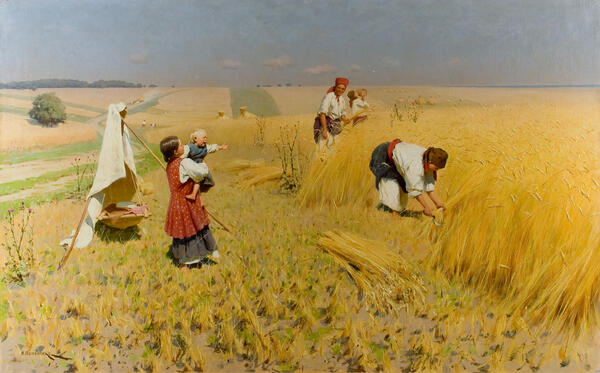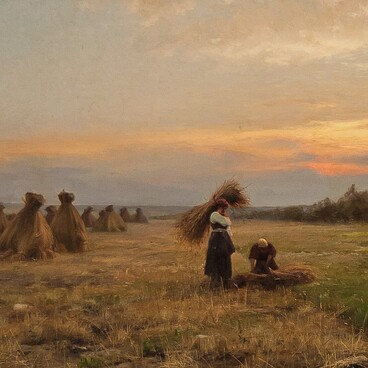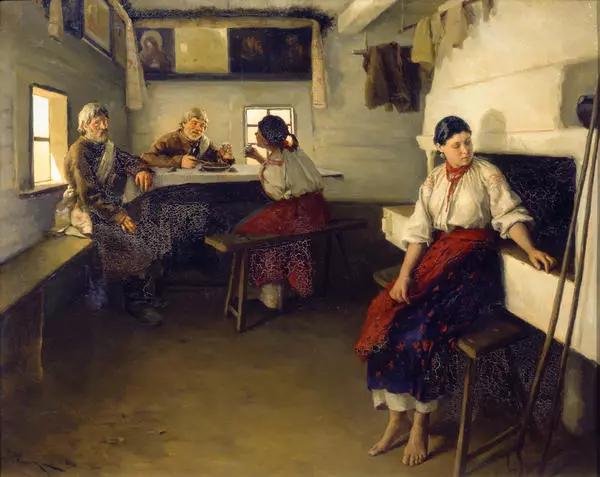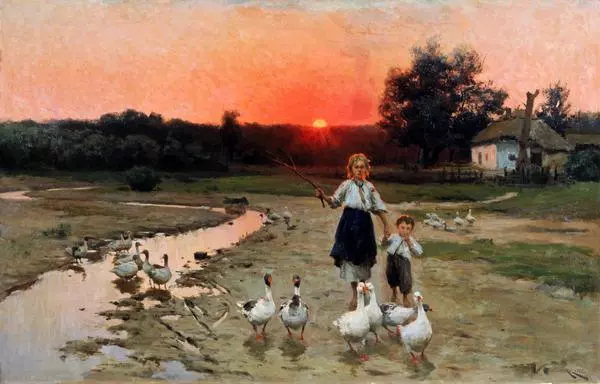Nikolay Pimonenko was one of the largest Ukrainian masters of genre painting in the last third of the 19th — early 20th centuries. The main theme of his work was the daily life of Ukrainian cities and villages.
From 1881 to 1911, the artist spent every summer in the village Malyutyanka, where he created a studio. Nature and villagers became the main characters of the picture ‘Harvest Gathering in Ukraine’. Peasant women are depicted on the crop residue against the background of a sunny summer landscape. In the field, there is a cradle fixed on poles dug in the ground.
In his paintings, Pimonenko sought to depict the unity of a man and nature. The color scheme of the picture and warm light shades create a calm lyrical mood.
The careful work-out of the foreground and background of the painting, the precisely constructed composition that opens a panoramic view of the surrounding landscape, demonstrate the artist’s commitment to the academic style in painting.
Nikolay Pimonenko was born in the suburbs of Kyiv, studied icon painting at the Kyiv-Pechersk Lavra. In 1876, the founder and director of the Kyiv Painting School, Nikolay Murashko, noticed him. He spotted the boy’s talent and persuaded the philanthropist Nikolay Tereshchenko, who sponsored the school, to accept Pimonenko for free.
Pimonenko studied in the class of Joseph-Kazimir Budkevich and Khariton Platonov. In the second year of study, Pimonenko was recognized as the best student and enrolled in the staff as a tutor. In 1882, he graduated from school with the title of drawing teacher, passed the exams, and entered the Imperial Saint Petersburg Academy of Arts as a non-matriculated student. There, Pimonenko studied in the studio of Vladimir Orlovsky, whose daughter he later married. The Academy awarded him two minor and one major silver medal ‘For Success in Painting’. In 1884, due to health problems, the artist had to leave the Academy; he returned to Kyiv and entered the position of a senior teacher at the Kyiv Painting School. He worked there until the school closed in 1901.
Pimonenko took part in the organization of the Kyiv Art School, taught graphics at the Kyiv Polytechnic Institute. In 1891, the painter received the title of an honorary free community member of the Imperial Saint Petersburg Academy of Arts for the paintings ‘Wedding in the Kyiv Governorate’ and ‘Morning of the Resurrection of Christ’ displayed at the academic exhibition.
On January 1, 1897, Emperor Nicholas II awarded Pimonenko the Order of Saint Anna, 3d degree, for the creation of images of St. Nicholas and St. Alexandra in the Kyiv Cathedral of St. Vladimir.
The artist often participated in international exhibitions in Berlin, Paris, London, and Munich. In 1909, for the painting ‘Hopak’, he was awarded the gold medal of the Salon of the Society of French Artists. The Louvre subsequently acquired the painting.
Pimonenko was a member of the Society of Travelling Art Exhibitions, the Society of South Russian Artists, the Society of Munich Artists, and the Paris International Union of Art and Literature. In 1904, the Council of the Imperial Academy of Arts awarded him the honorary title of an academician of painting ‘for fame in the artistic field’.
From 1881 to 1911, the artist spent every summer in the village Malyutyanka, where he created a studio. Nature and villagers became the main characters of the picture ‘Harvest Gathering in Ukraine’. Peasant women are depicted on the crop residue against the background of a sunny summer landscape. In the field, there is a cradle fixed on poles dug in the ground.
In his paintings, Pimonenko sought to depict the unity of a man and nature. The color scheme of the picture and warm light shades create a calm lyrical mood.
The careful work-out of the foreground and background of the painting, the precisely constructed composition that opens a panoramic view of the surrounding landscape, demonstrate the artist’s commitment to the academic style in painting.
Nikolay Pimonenko was born in the suburbs of Kyiv, studied icon painting at the Kyiv-Pechersk Lavra. In 1876, the founder and director of the Kyiv Painting School, Nikolay Murashko, noticed him. He spotted the boy’s talent and persuaded the philanthropist Nikolay Tereshchenko, who sponsored the school, to accept Pimonenko for free.
Pimonenko studied in the class of Joseph-Kazimir Budkevich and Khariton Platonov. In the second year of study, Pimonenko was recognized as the best student and enrolled in the staff as a tutor. In 1882, he graduated from school with the title of drawing teacher, passed the exams, and entered the Imperial Saint Petersburg Academy of Arts as a non-matriculated student. There, Pimonenko studied in the studio of Vladimir Orlovsky, whose daughter he later married. The Academy awarded him two minor and one major silver medal ‘For Success in Painting’. In 1884, due to health problems, the artist had to leave the Academy; he returned to Kyiv and entered the position of a senior teacher at the Kyiv Painting School. He worked there until the school closed in 1901.
Pimonenko took part in the organization of the Kyiv Art School, taught graphics at the Kyiv Polytechnic Institute. In 1891, the painter received the title of an honorary free community member of the Imperial Saint Petersburg Academy of Arts for the paintings ‘Wedding in the Kyiv Governorate’ and ‘Morning of the Resurrection of Christ’ displayed at the academic exhibition.
On January 1, 1897, Emperor Nicholas II awarded Pimonenko the Order of Saint Anna, 3d degree, for the creation of images of St. Nicholas and St. Alexandra in the Kyiv Cathedral of St. Vladimir.
The artist often participated in international exhibitions in Berlin, Paris, London, and Munich. In 1909, for the painting ‘Hopak’, he was awarded the gold medal of the Salon of the Society of French Artists. The Louvre subsequently acquired the painting.
Pimonenko was a member of the Society of Travelling Art Exhibitions, the Society of South Russian Artists, the Society of Munich Artists, and the Paris International Union of Art and Literature. In 1904, the Council of the Imperial Academy of Arts awarded him the honorary title of an academician of painting ‘for fame in the artistic field’.






